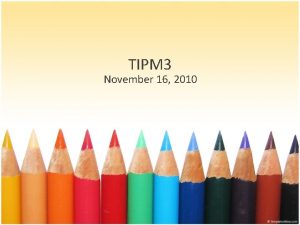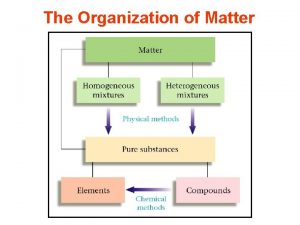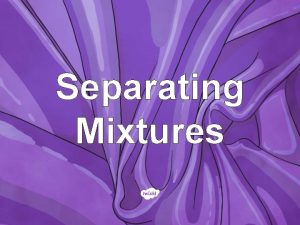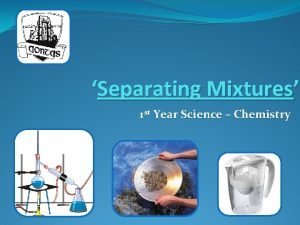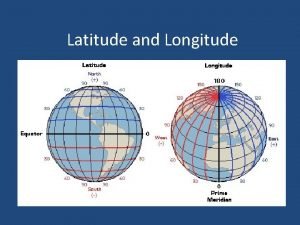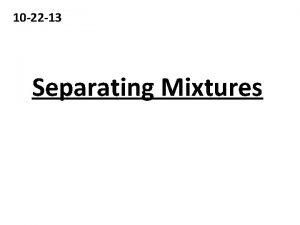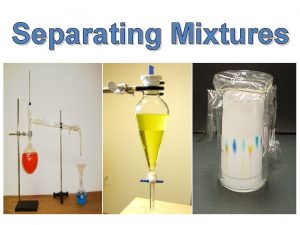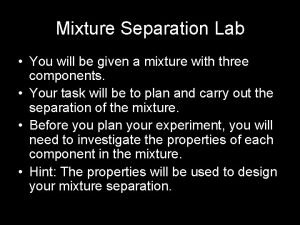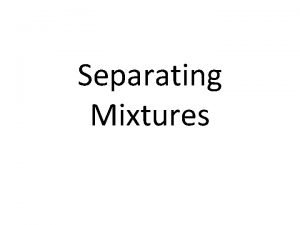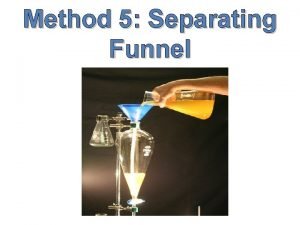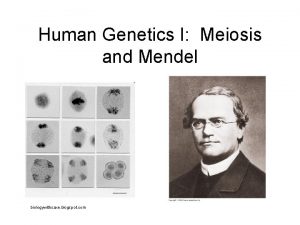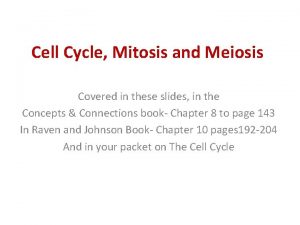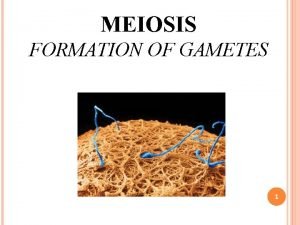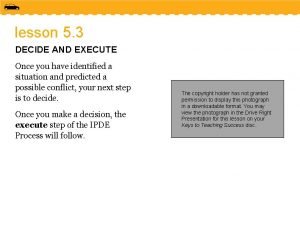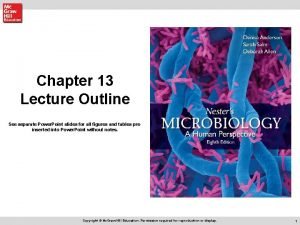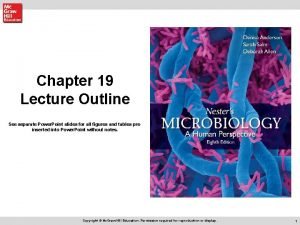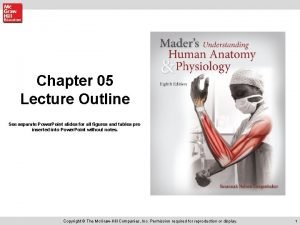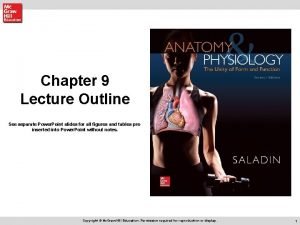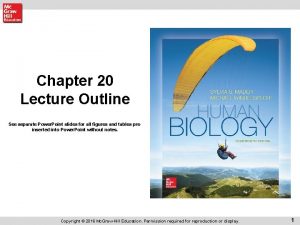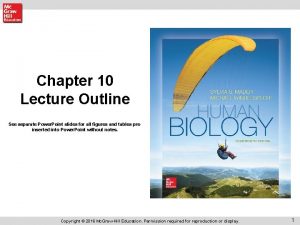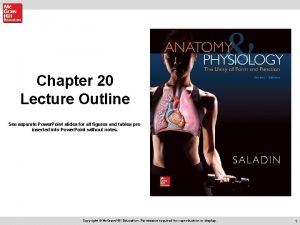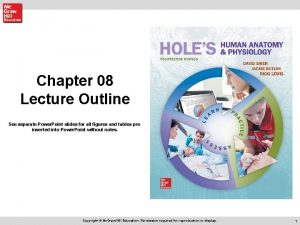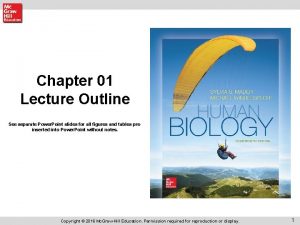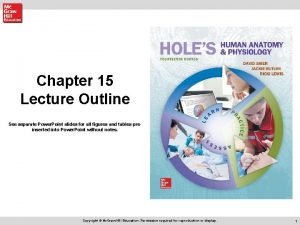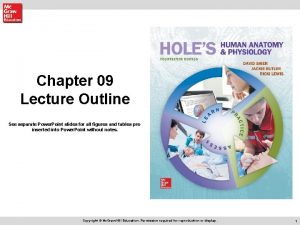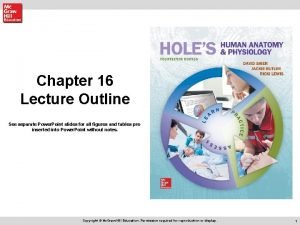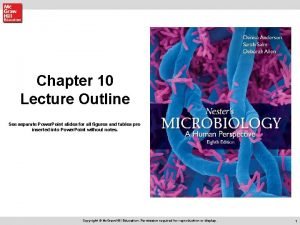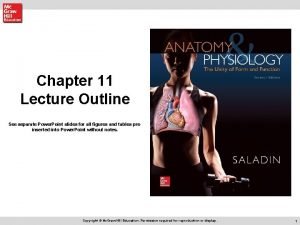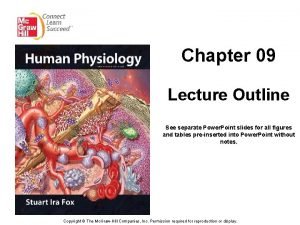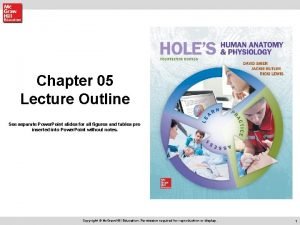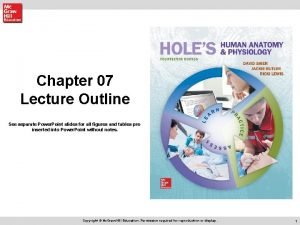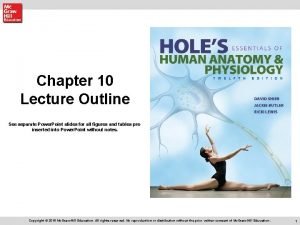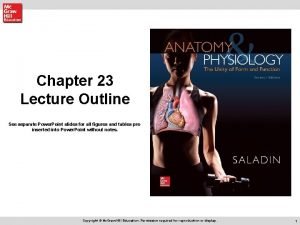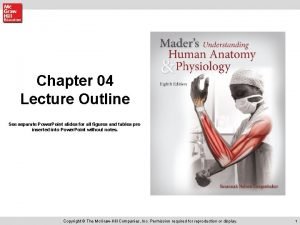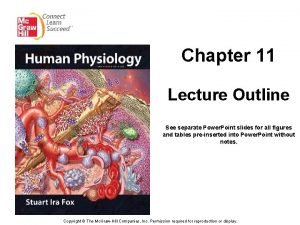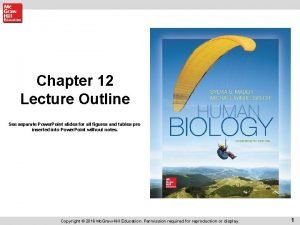Chapter 01 Lecture Outline See separate Power Point

































































- Slides: 65

Chapter 01 Lecture Outline See separate Power. Point slides for all figures and tables pre-inserted into Power. Point without notes. Copyright © The Mc. Graw-Hill Companies, Inc. Permission required for reproduction or display.

I. Introduction to Physiology

A. What is Physiology? 1. Study of biological function; how the body works a. Concerned with the normal function of cells b. Emphasizes mechanisms – how it works c. Explains using cause and effect sequences d. Derived from scientific experiments

2. Pathophysiology a. Concerns how disease or injury affects physiological processes b. Aids understanding of normal processes 3. Comparative physiology a. Studies the differences and similarities in the functions of invertebrates and vertebrates b. Has aided in the development of pharmaceutical drugs

B. The Scientific Method 1. Steps a. Make observations. b. Form a hypothesis; the hypothesis must be testable. c. Design and conduct experiments or make more observations. d. Analyze the data. e. Results must be replicated many times before a conclusion is accepted. f. Several verified hypotheses may become a general theory.

2. Measurements, Controls, and Statistics a. Good physiological research requires: 1) 2) 3) 4) Quantifiable measurements An experimental group and a control group Statistical analysis Review and publication by a peer-reviewed journal

3. Developing Pharmaceuticals a. Basic research is conducted for years before a drug is ever given to a person. b. Research begins by studying the effects of a chemical on cells in vitro (in a culture dish). c. Next, studies are done in animals (usually rats and mice) to see if the same effects occur in vivo (in a living creature) and if there any toxic side effects. 1) For these trials, many rats and mice are genetically modified to be susceptible to particular diseases. 2) Animal trials may take several years.

d. Phases of clinical trials 1) Phase I clinical trials test the drug on healthy human volunteers to test for side effects, rates of passage, dosage, etc. 2) Next the drug goes into phase II clinical trials to test its effectiveness on people with the particular disease. 3) Phase III clinical trials are conducted on a large number of people to include both sexes, many age groups and ethnicities, and people with more than the one health condition. From here the FDA can approve the drug for sale. 4) Phase IV trials test other applications for the drug.

II. Homeostasis and Feedback Control

A. Brief history of physiology 1. Aristotle – Greece (384 -322 BC) – speculated about body function (thinkers, not doers) 2. William Harvey – England (1578 -1657) – demonstrated that the heart pumps through a closed system of vessels 3. Claude Bernard – France (1813 -1878) – observed that the internal environment (milieu interieur) stays relatively constant although changes are occurring 4. Walter Cannon – US (1932) – coined the term, homeostasis, to describe the internal consistency of the body

B. Homeostasis 1. Homeostasis is constancy of the internal environment. 2. The main purpose of our physiological mechanisms is to maintain homeostasis. 3. Deviation from homeostasis indicates disease. 4. Homeostasis is accomplished most often by negative feedback loops.

C. Negative Feedback Loops 1. Pathway a. Sensors in the body to detect change and send information to the: b. Integrating center, which assesses change around a set point. The integrating center then sends instructions to an: c. Effector, which can make the appropriate adjustments to counter the change from the set -point

2. Mechanism of negative feedback loops a. Moves in the opposite direction from the change b. Makes the change from the set-point smaller c. Reverses the change in the set-point d. This is a continuous process, always making fine adjustments to stay in homeostasis

Negative Feedback Loops Copyright © The Mc. Graw-Hill Companies, Inc. Permission required for reproduction or display. 1 1 Sensor X Integrating center X Sensor X Effector Integrating center – – Effector X 2 2 Sensor activated Normal range Effector activated 1 X 2 Time X Normal range 1 Sensor activated 2 Effector activated

3. Body temperature example of negative feedback loops a. Sensors in the brain detect deviation from 37ºC. Another part of the brain assesses this as actionable, and effectors (sweat glands) are stimulated to cool the body. b. Once the body is cool, sensors alert the integrating center, and sweat glands are inhibited. c. The end result regulates the entire process. Production of the end product shuts off or downregulates the process. This is why it is called a negative feedback loop.

4. Antagonistic Effectors a. Homeostasis is often maintained by opposing effectors that move conditions in opposite directions. 1) This maintains conditions within a certain normal range, or dynamic constancy. 2) When you are hot, you sweat; when you are cold, you shiver. These are antagonistic reactions. b. Other examples – blood glucose levels, blood p. H

Antagonistic Effectors Copyright © The Mc. Graw-Hill Companies, Inc. Permission required for reproduction or display. Set point (average) – – – Normal range Copyright © The Mc. Graw-Hill Companies, Inc. Permission required for reproduction or display. Sweat Normal range 37° C Shiver

5. Quantitative Measurements a. A knowledge of normal ranges aids in diagnosing diseases and in assessing the effects of drugs and other treatments in experiments.

Quantitative Measurements

D. Positive Feedback 1. The end product in a process stimulates the process. 2. The action amplifies the changes that stimulated the effectors 3. Positive feedback could not work alone, but it does contribute to many negative feedback loops. a. For example, if a blood vessel is damaged, a process is begun to form a clot. Once the damage is fixed, clotting ends (negative feedback). However, the process of forming the clot involves positive feedback. b. The strength of uterine contractions during childbirth is also regulated by a positive feedback loop.

E. Intrinsic and Extrinsic Regulation 1. Regulation of processes within organs can occur in two ways: a. Intrinsically: Cells within the organ sense a change and signal to neighboring cells to respond appropriately. b. Extrinsically: The brain (or other organs) regulates an organ using the endocrine or nervous system.

Neural and Endocrine Regulation, cont 3. The nervous system “innervates” organs with nerve fibers. 4. The endocrine system releases hormones into the blood, which transports them to multiple target organs.

Neural and Endocrine Regulation Copyright © The Mc. Graw-Hill Companies, Inc. Permission required for reproduction or display. Sensor Integrating center Effector Negative feedback response Lying down – Standing up 1. Blood pressure falls 4. Rise in blood pressure Stimulus 3. Heart rate increases 2. Blood pressure receptors respond Effector Motor nerve fibers Medulla oblongata of brain Integrating center Sensory nerve fibers Sensor

F. Feedback Control of Hormone Secretions 1. Hormones are secreted in response to specific stimuli. a. Example - An increase in blood sugar results in the release of insulin, which removes sugar from the blood. 2. Secretion can be inhibited by its own effects. a. Example - Decreased blood sugar inhibits the release of insulin.

Feedback Control of Hormone Secretions, cont 3. Negative feedback inhibition usually involves an antagonist to make sure homeostasis is maintained within normal levels. a. Example - When blood sugar is low, the hormone glucagon is secreted, which results in a rise in blood sugar.

Feedback Control of Hormone Secretions Sensor Integrating center Effector Copyright © The Mc. Graw-Hill Companies, Inc. Permission required for reproduction or display. Fasting Eating Blood glucose Pancreatic islets (of Langerhans) – Insulin Glucagon Insulin Cellular uptake of glucose Glucose secretion into blood by liver Cellular uptake of glucose (a) Blood glucose (b) Blood glucose –

III. The Primary Tissues

A. Levels of organization 1. Cell – basic unit of structure and function of living things 2. Tissue – group of similar cells that perform a similar function 3. Organ – group of two or more tissues into structural and functional units 4. System – group of organs that work together to perform related functions 5. Organism – systems working together in coordination

B. The Primary Tissues 1. Our organs are composed of four major categories of tissues: a. Muscle tissue b. Nervous tissue c. Epithelial tissue d. Connective tissue 2. Each tissue has particular structures and functions that dictate the physiology of the organ.

C. Muscle Tissue 1. Specialized for contraction 2. The three types are: a. Skeletal muscle b. Cardiac muscle c. Smooth muscle

3. Skeletal Muscle Tissue a. Voluntary muscle (muscle you can consciously control) b. Most associated with bones that are pulled to produce movements c. A few do not cause skeletal movement but are under conscious control - tongue, esophagus, sphincters, and diaphragm d. Has cells organized in striations e. Union of separate cells called myoblasts to form myofibers – a syncytium f. Can produce a graded response

Skeletal Muscle Tissue Copyright © The Mc. Graw-Hill Companies, Inc. Permission required for reproduction or display. Muscle fibers Nucleus © Mc. Graw-Hill Companies, Inc. Al Telser, photographer

4. Cardiac Muscle Tissue a. Found only in the heart b. Fibers are short, branched, and interconnected both physically and electrically c. Striated, but very different in structure and action from skeletal muscle. d. Involuntary (you can not consciously control) e. Specialized cell connections called intercalated discs allow passage of sodium ions between cells. f. Can not produce a graded contraction

Cardiac Muscle Tissue Copyright © The Mc. Graw-Hill Companies, Inc. Permission required for reproduction or display. Nucleus Intercalated discs © Mc. Graw-Hill Companies, Inc. Al Telser, photographer

5. Smooth Muscle Tissue a. Found in the walls of digestive, urinary, and reproductive organs, blood vessels, and bronchioles of the lungs (hollow organs) b. Not striated, involuntary c. Generally found in layers that run different directions d. Peristalsis – coordinated, wave-like contraction of smooth muscle layers to more substances through the organs

Smooth Muscle Tissue Copyright © The Mc. Graw-Hill Companies, Inc. Permission required for reproduction or display. Nuclei © The Mc. Graw-Hill Companies, Inc. /Dennis Strete, photographer

D. Nervous Tissue 1. Found in the brain, spinal cord, and nerves 2. Composed of neurons and neuroglia 3. Neurons conduct impulses and have three parts: a. Dendrites: short, highly branched, cytoplasmic extensions that receive signals b. Axon: long, single extension that sends signal c. Cell body: metabolic center containing the nucleus 4. Neuroglia are supporting cells that do not conduct a nerve impulse but are essential for neuron function

Nervous Tissue Copyright © The Mc. Graw-Hill Companies, Inc. Permission required for reproduction or display. Dendrites Cell body Supporting cells Axon © Ed Reschke

E. Epithelial Tissue 1. Forms the membranes that cover body surfaces, line the inside of hollow organs, and glands 2. Epithelial membranes are classified by the number of layers: a. Simple epithelium has one layer and is specialized for transport of substances. b. Stratified epithelium is composed of multiple layers and provides protection.

Epithelial Tissues, cont 3. Epithelial tissues are also classified by the shape of their cells: a. Squamous: flattened cells b. Cuboidal: as tall as they are long c. Columnar: tall cells 4. Put the cell shape together with the number of layers to name epithelial tissue 5. Some modifications can occur such as in columnar tissues that have goblet cells that secrete mucus and cilia that move in a coordinated fashion.

Epithelial Tissues

6. Simple Epithelial Tissues a. Simple squamous epithelium allows for rapid diffusion as in the alveoli of the lungs b. Simple cuboidal epithelium allows for secretion of substances as in various glands c. Simple columnar epithelium allows for absorption as found in the wall of the small intestine

Simple Epithelial Tissues

7. Stratified Epithelial Tissue a. To provide protection, cells of stratified epithelial tissues are held together by structures called junctional complexes. 1) These are too close together to house blood vessels, so are nourished by connective tissues beneath. 2) Epithelial tissues are attached to connective tissues by a basement membrane.

a. Nonkeratinized membranes have living cells in all layers b. Keratinized membranes have cells filled with keratin, a water-resistant protein, and layers of dead cells on the surface 8. Epithelial membranes continually renew by losing surface cells and replacing with new cells

Stratified Epithelial Tissue - nonkeratinized Copyright © The Mc. Graw-Hill Companies, Inc. Permission required for reproduction or display. Cytoplasm Nucleus Squamous surface cells Mitotically active germinal area Basement membrane Connective tissue (a) (b) a: © Ed Reschke

Stratified Epithelial Tissue - keratinized Copyright © The Mc. Graw-Hill Companies, Inc. Permission required for reproduction or display. Keratinized layer Epidermis Extracellular material: collagen fibers, scattered cells, tissue fluid Dermis A blood capillary A lymph capillary, which helps drain off tissue fluid The capillary wall– a living, semipermeable membrane

9. Exocrine Glands a. Derived from epithelial tissues b. Secretions are transported by ducts. 1) Examples include lacrimal, sweat, and sebaceous glands; digestive enzyme glands; and the prostate. c. Secretory portions may be tubes or acini groups d. Sweat glands 1) Eccrine - more numerous; secrete a salty sweat; involved in thermoregulation 2) Apocrine – located in axilla and pubic region; protein-rich sweat that bacteria feed on

F. Connective Tissues 1. Characterized by a matrix made up of protein fibers, extracellular material, and specialized cells 2. There are four major categories: a. Connective tissue proper b. Cartilage c. Bone d. Blood

3. Connective Tissue Proper a. Composed of protein fibers and a gel-like ground substance b. Subtypes: 1) Loose: collagen fibers scattered loosely with room for blood vessels and nerves • Example: upper layer of the dermis of the skin 2) Dense regular: Densely packed collagen fibers with little room for ground substance • Examples: tendons and ligaments

Connective Tissue Proper Loose Connective Dense regular connective Copyright © The Mc. Graw-Hill Companies, Inc. Permission required for reproduction or display. Extracellular matrix Protein fibers (collagen) Ground substance Copyright © The Mc. Graw-Hill Companies, Inc. Permission required for reproduction or display. Mesenchymal cell Elastic fibers Fibroblast Collagen fibers Reticular fibers Fibroblast nucleus Macrophage © The Mc. Graw-Hill Companies, Inc. /Photo by Dr. Alvin Telser Adipocyte (fat cell) Blood vessel

Connective Tissue Proper subtypes, cont 3) Adipose tissue stores fat; cells called adipocytes 4) Dense irregular connective tissue is composed of densely packed collagen fibers in various arrangements to resist forces.

Connective Tissue Proper – adipose tissue Copyright © The Mc. Graw-Hill Companies, Inc. Permission required for reproduction or display. (a) Nucleus of adipocyte Fat globule Cytoplasm Cell membrane (b) a: © The Mc. Graw-Hill Companies, Inc. /Al Telser, photographer

4. Cartilage Connective Tissue a. Composed of cells called chondrocytes surrounded by a semi-solid ground substance b. Serves as a template skeleton during bone development c. Found in joints to provide a gliding surface for bones

5. Bone a. Cells called osteoblasts trap mineral salts, forming concentric layers of calcified material around a canal filled with blood vessels and nerves. b. Once the matrix has hardened, the cells are called osteocytes and live in spaces called lacunae c. The dentin of a tooth is similar to bone and is made by cells in the pulp; the outer enamel is harder than bone or dentin

Bone Copyright © The Mc. Graw-Hill Companies, Inc. Permission required for reproduction or display. (a) (b) Lamellae Central canal Osteocyte within a lacuna Canaliculi (c) b: © Ed Reschke

IV. Organs and Systems

A. Organs 1. An organ is composed of two or more tissues that serve different functions in the organ. 2. The skin is the largest organ in the body. a. The skin has all four primary tissues. b. Epidermis – keratinized stratified squamous epithelium to protect against water loss and abrasion c. Dermis – dense irregular connective tissue containing exocrine glands, hair follicles, sense receptors, and blood vessels d. Hypodermis – adipose tissue for padding and insulation

Organs – The Skin Copyright © The Mc. Graw-Hill Companies, Inc. Permission required for reproduction or display. Hair Sebaceous gland Sweat pore Stratum corneum Epidermis (Epithelial tissue) Stratum granulosum Stratum spinosum Stratum basale Arrector pili muscle (Muscle tissue) Dermis (Connective tissue) Sweat gland Hypodermis Arteriole Venule Adipose tissue Hair bulb Motor nerve (Nerve tissue) Sensory nerve

3. Stem cells a. Tissue Development 1) Tissues are composed of highly specialized cells that arise from three embryonic germ layers: a) Endoderm b) Mesoderm c) Ectoderm

b. Types of Stem Cells 1) Zygotes are totipotent, which means their cells can become any type of cell. These are true stem cells. 2) As cells begin to differentiate, a few adult stem cells are retained to allow for cell replacement. 3) Adult stem cells are still limited to a narrow range of possibilities but can become several related cells and thus are called multipotent. (Bone marrow cells can become any type of blood cell) 4) Embryonic stem cells are pluripotent – can form any type of unrelated cells

Stem cells in bulge of hair follicle Copyright © The Mc. Graw-Hill Companies, Inc. Permission required for reproduction or display. Hair Epidermis Basal layer Outer root sheath Sebaceous gland Inner root sheath Bulge region with stem cells Matrix Dermal papilla

B. Systems 1. Organs that perform related functions are grouped into systems. 2. Humans have 11 inter-related organ systems

Systems

C. Body Fluid Compartments 1. Intracellular: area inside the cells; contains 65% of total body water 2. Extracellular: area outside the cells; examples: blood plasma and interstitial fluid 3. Both body fluid compartments are filled primarily with water and are separated by membranes.
 Point-by-point essay outline example
Point-by-point essay outline example 01:640:244 lecture notes - lecture 15: plat, idah, farad
01:640:244 lecture notes - lecture 15: plat, idah, farad Draw power triangle
Draw power triangle Powerbi in powerpoint
Powerbi in powerpoint Point point power
Point point power Lecture outline example
Lecture outline example Lecture outline example
Lecture outline example Lecture outline example
Lecture outline example Lecture outline meaning
Lecture outline meaning Example of sentence outline
Example of sentence outline Chapter 1 a separate peace
Chapter 1 a separate peace Chapter 8 separate financial statements
Chapter 8 separate financial statements Power system dynamics and stability lecture notes
Power system dynamics and stability lecture notes Power system analysis lecture notes
Power system analysis lecture notes Power semiconductor devices lecture notes
Power semiconductor devices lecture notes Switch mode power supply lecture notes
Switch mode power supply lecture notes Power system dynamics and stability lecture notes
Power system dynamics and stability lecture notes Things fall apart traditions and customs
Things fall apart traditions and customs 5 paragraph
5 paragraph Management fifteenth edition
Management fifteenth edition Chapter 1 introduction to human resource management
Chapter 1 introduction to human resource management Human resource management lecture chapter 1
Human resource management lecture chapter 1 Comma independent clause
Comma independent clause Separate result unknown
Separate result unknown Filtration
Filtration How to separate raisins and flour
How to separate raisins and flour Apparatus used in evaporation
Apparatus used in evaporation Separate course salad
Separate course salad Gues bill adalah
Gues bill adalah Separate result unknown
Separate result unknown Important lines of latitude and longitude
Important lines of latitude and longitude Genre of a separate peace
Genre of a separate peace Double hashing example
Double hashing example Separate chaining hash table
Separate chaining hash table Are english language and literature separate gcses
Are english language and literature separate gcses Living things grow images
Living things grow images Using commas to separate coordinate adjectives
Using commas to separate coordinate adjectives Commas around in fact
Commas around in fact Oxford comma debate
Oxford comma debate Commas to separate adjectives
Commas to separate adjectives Cognitively guided instruction
Cognitively guided instruction A separate peace setting
A separate peace setting How to separate salt and sand chemistry
How to separate salt and sand chemistry Phantom line
Phantom line Classi sociali spartane
Classi sociali spartane 5 importance of separating mixtures
5 importance of separating mixtures How to separate mechanical mixtures
How to separate mechanical mixtures How to separate sand and finely ground polystyrene foam
How to separate sand and finely ground polystyrene foam Basic application software
Basic application software The pearl vocabulary
The pearl vocabulary One's self i sing poem analysis
One's self i sing poem analysis Sifting separating mixtures
Sifting separating mixtures Separation funnel diagram
Separation funnel diagram Independent assortment in metaphase 1
Independent assortment in metaphase 1 What is used to separate parts of any series
What is used to separate parts of any series Using commas to separate clauses
Using commas to separate clauses Cleavage furrow in cell division
Cleavage furrow in cell division A separate peace test
A separate peace test A separate peace quiz
A separate peace quiz Phil latham a separate peace
Phil latham a separate peace Your love never fails
Your love never fails Hash function code
Hash function code How to separate heterogeneous mixtures
How to separate heterogeneous mixtures Integrated quotation
Integrated quotation First polar body
First polar body You separate hazards when you adjust your
You separate hazards when you adjust your























